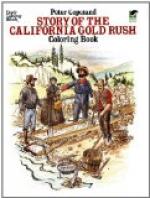Then Americans began to come in, the first party of hunters and trappers travelling from Salt Lake City to the San Gabriel Mission. All kept talking of the rich country where farming was so easy, and they wished to have land. But the Mexicans and the native Californians did not believe in allowing the Americans, as they called all the people from the Eastern states, to take up their farming lands and hunt and trap the wild animals. So there was much quarrelling. But the Americans still poured in, got land grants, and built houses.
In 1836, though Alta California declared itself a free state, and no longer looked to Mexico for support, Mexican rule still continued. The United States had wanted California for a long time, and had tried to buy it from Mexico. The fine bay and harbor of San Francisco, known to be the best along the coast, was especially needed by the United States as a place to shelter or repair ships on their way to the Oregon settlements. England also wanted this bay, but the Californians tried to keep every one out of their country.
Among the Americans who came overland and across the Rocky Mountains about this time was John C. Fremont, a surveyor and engineer, who was called the “Pathfinder.” On his third trip to the Pacific Coast in ’46 he wished to spend the winter near Monterey, with his sixty hunters and mountaineers. Castro, the Mexican general, ordered him to leave the country at once, but Fremont answered by raising the American flag over his camp. As Castro had more men, Fremont did not think it wise to fight, but marched away, intending to go north to Oregon. He turned back in the Klamath country on account of snow and Indians, as he said, and camped where the Feather River joins the Sacramento. It is almost certain that Fremont wished to provoke Castro and the Californians into war, and so to capture the country for the United States.
A party of Fremont’s men rode down to Sonoma, where there was a Mission, and also a presidio with a few cannon in charge of General Vallejo. These men captured the place and sent Vallejo and three other prisoners back to Fremont’s camp. Then the independent Americans concluded to have a new republic of their own, and a flag also. So they made the famous “Bear-flag” of white cloth, with a strip of red flannel sewed on the lower edge, and on the white they painted in red a large star and a grizzly bear, and also the words “California Republic.” They then raised the flag over the Bear-flag Republic. Many Americans joined their party, but when the American flag went up at Monterey, the stars and stripes replaced the bear-flag.
At this time the United States and Mexico were at war on account of Texas, and Commodore Sloat was in charge of the warships on the Pacific Coast. The commodore had been told to take Alta California, if possible; so, sailing to Monterey, he raised the stars and stripes there in July, 1846, and ended Mexican power forever. The American flag flew at the San Francisco Presidio two days later, and also at Sonoma, Sutter’s Fort, or wherever there were Americans. The flag was greeted with cheers and delight. Then Commodore Sloat turned the naval force over to Stockton and returned home, leaving all quiet north of Santa Barbara.




